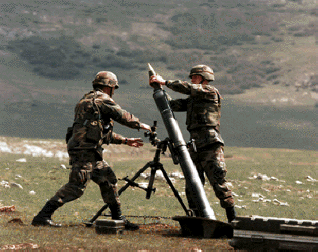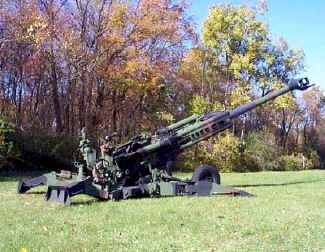The problem of employing artillery to support rapidly advancing forces on a chaotic, increasingly urbanized battlefield remains a problem. Communications can be jammed and artillery systems are less mobile than maneuver forces. As a result, the Marine Corps is considering adding 120mm mortars, and the US Army (which already has 120mm mortars in its mech infantry and armored divisions) may include them in its light infantry divisions.
A better solution is a 155mm mortar, which could fire the current variety of 155mm artillery shells up to four miles away. It could be mounted on APCs and or light trucks like HMMWVs. This is possible since limiting its range allows a lighter weapon which produces far less recoil. It would need a rifled tube like the old (4.2 inch) 107mm mortar, to fire 155mm howitzer munitions. Since these rounds are not rocket propelled like most mortars, bag charges would be tossed in the tube and the two men would use a special carrier to hoist up and drop a 90-pound 155mm munition, or it may be breech-loaded like the 160mm mortars used by Russia, Finland, and Israel. Interestingly, the Israeli army has used this heavy self-propelled mortar concept when it mounted 160mm "Soltarm" mortars on World War II Sherman tank chassis.
 A 155mm mortar could fire new SADARM rounds at armored vehicles, and regular HE and ICM "bomblet" rounds at infantry.
If more range is needed, rocket-assisted rounds could be used. Most importantly, accurate Copperhead laser-guided rounds could
be employed. This munition has been in our military's inventory for years and has proven extremely reliable.
Copperheads can easily destroy tanks and bunkers, but are rarely used since commanders do not consider artillery a precision
weapon, and because they seem expensive. However, using a $5000 copperhead
to destroy a million dollar tank is quite a bargain. Since the mortar crew
would designate it's own targets with a laser, there would be no problem
aligning the spot with the gun tube to ensure a Copperhead can see the target.
A 155mm mortar could fire new SADARM rounds at armored vehicles, and regular HE and ICM "bomblet" rounds at infantry.
If more range is needed, rocket-assisted rounds could be used. Most importantly, accurate Copperhead laser-guided rounds could
be employed. This munition has been in our military's inventory for years and has proven extremely reliable.
Copperheads can easily destroy tanks and bunkers, but are rarely used since commanders do not consider artillery a precision
weapon, and because they seem expensive. However, using a $5000 copperhead
to destroy a million dollar tank is quite a bargain. Since the mortar crew
would designate it's own targets with a laser, there would be no problem
aligning the spot with the gun tube to ensure a Copperhead can see the target.
A battery of 155mm mortars could be attached to infantry battalions and advance with them. Commanders will feel more comfortable employing nearby weaponry under his direct control, and would discover that 155mm mortars are his best anti-tank weapons. These mortar crews would have their own laser designator and often adjust fires from direct observation.
The US Army and Marine Corps are evaluating a new lightweight 155mm towed howitzer. This weapon will prove to be very expensive, and may suffer long-term reliability problems because of its light construction. The M198 howitzer it will replace had several stress related problems, and it weighs twice as much (16,800 pounds). More importantly, it is a towed weapon which is difficult to rapidly employ and awkward to transport.
A 155mm mortar should be inexpensive and simple to construct. Ideally, it would use current 120mm mortar systems, and just substitute a 155mm tube. It would not replace the role of long-range heavy artillery, but provide forward units with "hip pocket" artillery with a high sustained rate of fire, and high-angle of fire to destroy targets masked from the arc of howitzer rounds. 155mm mortars would provide airborne and heliborne units with highly mobile, heavy firepower, which can set up and fire rounds within a minute. Armies may eventually replace both 105mm howitzers and 120mm mortars with 155mm mortars to simplify ammunition procurement and supply.
Carlton Meyer editorG2mil@Gmail.com
Also read: Heavy American Mortars in WW II
Letters
Heavy Mortars are Needed
Great article on the 155 mm mortar. Couldn't agree more....its possibilities like the above, using currently available technology that leads me to believe that the traditional howitzer cannons supporting ground maneuver battalions are obsolete and extremely wasteful in terms of vehicles, manpower and mobility. An AirMech battalion could have either a self propelled 155 mm mortar battery or an AVENGER battery that can provide indirect HE, anti-armor, anti-personnel, smoke and even ADA fires! The only reluctance I have to not letting go with mortars is the economy and precision of single HE rounds and their plunging fire support so necessary to to ground maneuver. I'm not sure an AVENGER rocket option could duplicate the short range immediate suppressive fires as efficiently as a mortar. I favor the 155mm caliber mortar because of the advantages of using the full family of sophisticated 155 mm rounds available, from COPPERHEAD, SADARM to FASCAM to ICM. Based on the weights of similar Russian sized mortars, I estimate that a self propelled 155 mm mortar with 15 rounds could be made weighing 8000 lbs. Based on perhaps on a HMMWV chassis. This large a caliber may cause significant problems with rates of fire and range which may lead to a 120 mm caliber NATO standard. In either case, I feel that an AVENGER-Rocket combination along with a precision-capable 120 mm mortar or larger is sufficient for battalion fire needs. If the battalion needs greater fire power, then the T-MARS or EFOG-M batteries at higher could be at tapped. If however, the 'STRIKE' concept is used, then there should be little need for the old concept of massed howitzers firing DS for a maneuver battalion. There won't be a MMR rolling up against the defences of a battalion TF in typical 'Fulda Gap' scenario fashion."
US Army Major
HowTars
Interesting article about 155mm mortars. I used to be in the Firepower Branch at Ft Benning. Worked with several people to get the 120MM Tampella mortar demonstrated/adopted. Also participated in the 60mm mortar on tank test (part of the effort to use Israeli experience in the late 70s - early 80s. However, I digress: If you visit Picatinny Arsenal, the museum has (or had, last time I was there many years ago) two odd-looking weapons sitting outside. These were the 105mm and 155mm HowTars or Baseplate Howitzers (No one seemed at the time to be able to name them!). They fired conventional 105 and 155 artillery ammunition, were breech loaded, and used the baseplate and possibly limited recoil mechanisms to take the recoil. These were sent to Vietnam for testing and returned, placed on the shelf, and forgotten. As I recall, they were turned down because they gave the Infantry Battalion level commander too much range outside his operational area and the baseplates tended to dig themselves into the mud. (The folks who evaluated this probably never had to dig up a baseplate after rapid fire...I have seen I81 mortars buried up to the sights in Georgia clay, and have dug out too many 4.2" baseplates to want to think about them). I also suspect that the weapons were tested by the artillery, who really are not fond of mortars, rather than the Infantry. Also, the names are self-defeating: Rather than simply calling them a 105 or "155mm mortar, the titles chosen belonged to neither the Infantry or the Artillery.The baseplate howitzers are probably still at Picatinny, and you might be able to get the test reports on them if interested.
US Army Captain
©2002 www.G2mil.com